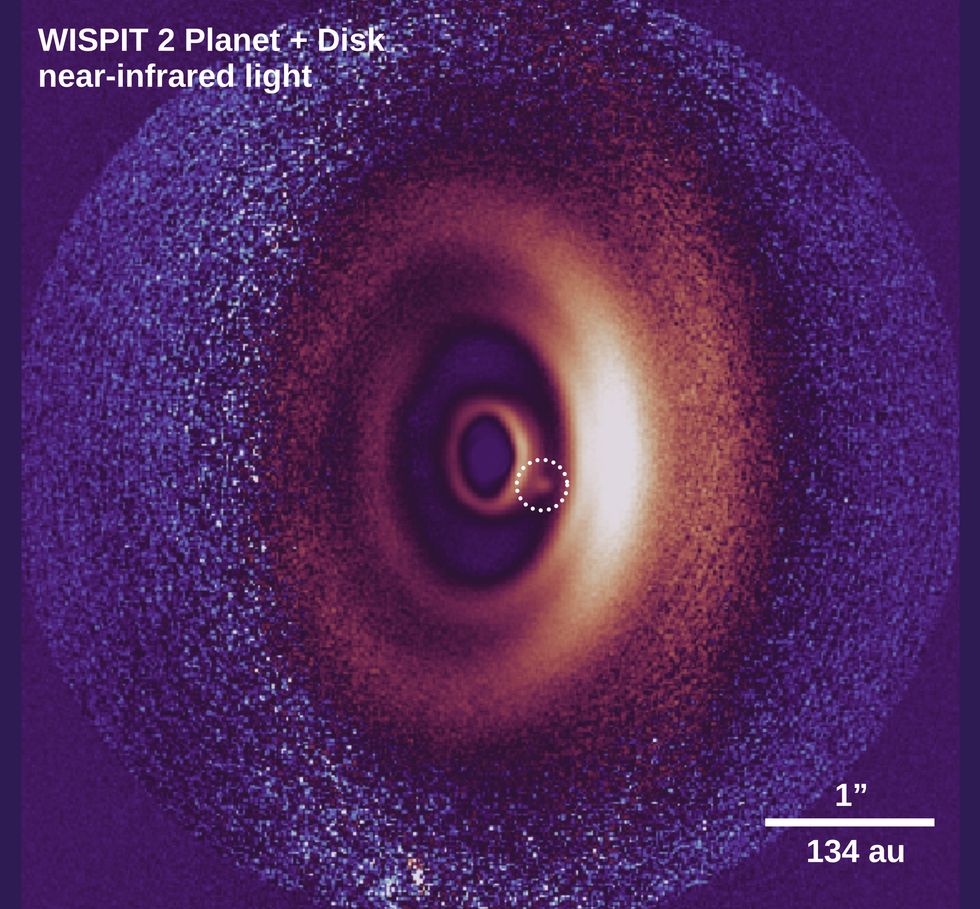
The unexpected detection of a new planet has been hailed as a “remarkable discovery” by Irish astronomers who were involved in its identification.
The newly spotted planet, named WISPIT 2b, is estimated to be about five million years old and most likely a gas giant of similar size to Jupiter.
It was detected by an international team, co-led by researchers at University of Galway, at an early stage of formation around a young star which shares similarities with our own Sun.
We instead detected a completely unexpected and exceptionally beautiful multi-ringed dust disk
Dr Christian Grinski, University of Galway
A study on the planet, which was led by Leiden University, the University of Galway and the University of Arizona, has been published in the international journal Astrophysical Journal Letters.
WISPIT 2b is about 430 light years away.
While not visible to the naked eye, curious stargazers may be interested to know it is lurking in the direction of the constellation Aquila, the eagle.
The groundbreaking discovery was made using one of the world’s most advanced observatories: the European Southern Observatory’s Very Large Telescope (ESO’s VLT) in the Atacama Desert in Chile.
Dr Christian Ginski, lecturer at the School of Natural Sciences, University of Galway and second author of the study, said: “We used these really short snapshot observations of many young stars – only a few minutes per object – to determine if we could see a little dot of light next to them that is caused by a planet.
“However, in the case of this star, we instead detected a completely unexpected and exceptionally beautiful multi-ringed dust disk.
“When we saw this multi-ringed disk for the first time, we knew we had to try and see if we could detect a planet within it, so we quickly asked for follow-up observations.”
It is only the second time a confirmed planet has been detected at this early evolutionary stage around a young version of our Sun. The first one was discovered in 2018, by a research team also involving Dr Ginski.
It’s a big one - that’s sure to spark discussion within the research community and advance our understanding of planet formation.
Jack Byrne, MSc student at University of Galway
The planet was captured in near infrared light – the type of view that someone would see when using night-vision goggles – as it is still glowing and hot after its initial formation phase.
The team at Leiden University and the University of Galway captured a spectacular clear image of the young proto-planet embedded in a disk gap.
They also confirmed that the planet is orbiting its host star.
The planet was further detected in visible light by a team from the University of Arizona using a specially designed instrument, with those findings indicating that the planet is still actively accreting gas as it is forming its atmosphere.
Dust and gas-rich disks around young stars are the birth cradles of planets.
They can look quite spectacular with many different structures such as rings and spiral arms, which researchers believe are related to planets forming within them.
The disk around WISPIT 2b has a radius of 380 astronomical units – about 380 times the distance between Earth and the Sun.
The study was led by an early career PhD student, Richelle van Capelleveen, from Leiden University, and co-led by a graduate student team at the University of Galway.
We were incredibly lucky
Richelle van Capelleveen, Leiden University
The research findings were co-authored by Dr Ginski and three physics graduate students who are specialising in astrophysics at the University of Galway.
Ms van Capelleveen said: “Discovering this planet was an amazing experience – we were incredibly lucky.”
Chloe Lawlor, a PhD student in physics with a specialisation in astrophysics at the University of Galway, said: “I feel incredibly fortunate to be involved in such an exciting and potentially career-defining discovery.
“WISPIT 2b, with its position within its birth disk, is a beautiful example of a planet that can be used to explore current planet formation models. I am certain this will become a landmark paper, owing particularly to the work of Richelle van Capelleveen and her exceptional team.”
Jake Byrne, an MSc student at University of Galway, said he “could hardly believe it was a real detection” when he first saw the image of the “remarkable discovery”.
“It’s a big one – that’s sure to spark discussion within the research community and advance our understanding of planet formation.”
Dan McLachlan, also an MSc student at the institution, said: “It was such a mind-blowing thing to be a part of.
“I feel so well treated by the University of Galway physics department and especially my supervisor Dr Christian Ginski to have provided me with the opportunity to be part of such an exciting project.”













